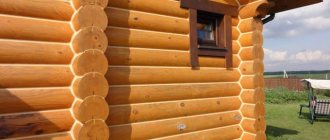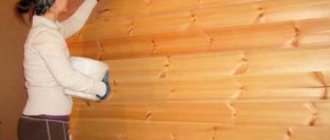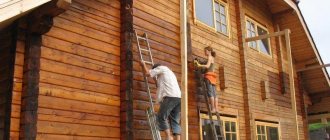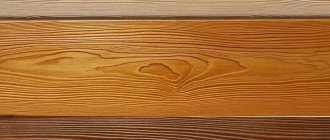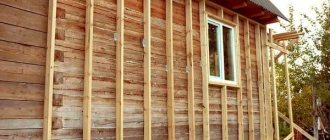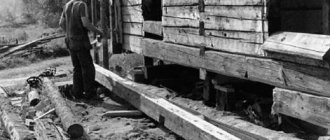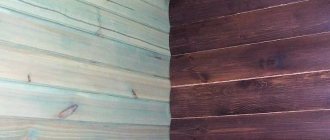Wooden lining is a beautiful, natural material. It is not surprising that so many users around the world prefer it as a finishing and facing material.
The environmental friendliness and natural beauty of wood not only decorates the room, but also creates a certain microclimate in it. And the lining covered with a thick coating (paint, varnish) allows you to create any decor.
But wood has a significant disadvantage that affects the performance characteristics of the lining - it is subject to rotting, various damage, and also tends to darken.
This article is intended for those who want to protect and at the same time preserve the lining in its natural form. Let's consider step by step how and what is the best way to coat (impregnate, treat, paint) wooden lining (euro lining).
I must say that the “take a brush, paint and paint” method is good precisely because of its simplicity. But how long will wood painted this way last? Wouldn't it be better to take a more thorough and correct approach?
Proper painting of wooden lining consists of 4 stages:
Tips for choosing a finishing coating for wooden lining
- color . Since stain or paint changes the color or shade of the lining, you need to use this property. For example, light shades visually increase the space. The use of different colors/shades allows you to zone the room;
- compound . The prefix “bio” after the name of the varnish indicates the absence of harmful substances. This composition can be used for interior work;
- manufacturer . Many domestic analogues of lining varnish or paint can create worthy competition for foreign goods. At the same time, the price of the product will be more humane.
How and with what to paint the lining in the bathhouse and steam room
Wax composition Evrotex-Sauna for lining in a bathhouse Due to the high temperature, it is better not to paint the lining in a bathhouse, but to treat it with protective compounds.
An excellent solution would be to use wax compounds, for example, Evrotex-Sauna. This coating is suitable for use in conditions of high temperature and cyclic intensive humidification.
Advice. You only need to apply the varnish once in the sauna. In the dressing room - you can make several layers.
How and with what to paint the lining on the veranda
The veranda or terrace is exposed to the greatest influence of atmospheric factors, so the material must be resistant. First coat with a layer of primer, and then 2-3 layers of varnish or paint.
How and with what to paint the lining inside/outside the house
There are no particular differences in painting a house outside or inside. The only difference is in the coatings used. Varnish/paint for interior work must meet environmentally friendly requirements. For outdoor work, it is more important that the coating can withstand moisture, temperature changes, and exposure to UV rays. The same type of paint can be used inside and outside a building. The difference is in the number of layers applied.
How to paint lining correctly - tool
To paint the lining you can use:
- brush. They are convenient because they allow you to paint wood in corners and hard-to-reach places. The paint is applied most evenly with a brush;
Advice. To apply the paint with a brush evenly and avoid smudges, you need to immerse the brush halfway in the paint.
- roller Allows you to paint quickly. However, to obtain a uniform layer you need to paint several times;
- spray. Allows you to get the job done as quickly as possible. But it increases paint consumption;
- mitten (chain-shaped). It is convenient to use a glove to paint (impregnate) the places where the lining joins (frames) the pipes;
- foam sponge.
Types of funds
Coverings for lining are divided into two main groups: protective and finishing (decorative). The first group includes compounds that have different working functions. Some are impregnations, others are covering materials. Both of them create a barrier against negative external factors.
Impregnations suitable for lining:
- covering soil;
- stain;
- wax;
- oil;
- specialized impregnation;
- antiseptics;
- drying oil;
- bleach;
- fire retardant
Several layers of stain with and without the addition of toners look different Source elka-palka.ru
Covering finishing materials act as a decorative layer, simultaneously serving as both protection and decoration. When there is no desire to cover up the wood pattern and its color, the coating composition is chosen from among the following translucent options:
- glossy or matte clear varnishes;
- tinted clear varnishes;
- translucent varnishes;
- wax;
- aqualak on acrylic;
- translucent enamel;
- decorative azure.
Brushed lining is coated with water-soluble transparent varnish Source 1povagonke.ru
For other cases in which the natural color, texture and pattern of the board are unimportant, the lining inside the house is treated using covering materials. These include:
- acrylate, acrylic paints;
- oil paints;
- water-based paints.
Painting new lining with acrylic paint - the first layer of light green color Source sparta-stroy.ru
Wax belongs to the group of coating materials and impregnations. It all depends on the technology and the thickness of the applied layer. The degree of gloss of the coating depends on the duration and technique of polishing during waxing. In this case, wax can be called a coating material. The longer the procedure is carried out, the more the working wax surface approaches gloss. The less and less intensive grinding is done, the more the matte structure of the wax coating is preserved.
Wood paneling painting technology
- Before painting or applying varnish/paint, they must be mixed well. This way they will lie more evenly;
- a test paint will allow you to understand what the painted surface will look like;
- It is better to apply the paint in several thin layers. This way, each layer will dry faster and the coating will be applied more evenly;
- the next layer of paint/varnish should be applied only after the first one has completely dried;
- When painting the lining, you need to leave gaps of 2-3 cm at the top and bottom of the panels. This will allow the tree to breathe. And the gaps themselves can be closed with decorative plinths;
- to avoid obtaining different shades of wood, it is better to paint with paint at a time, using material from one batch;
- if there is a need to interrupt work, try to make sure that the “seam”, the border of the painted and unpainted area, is not in a visible place;
Tips for storing an open can of paint:
If work is interrupted for a long time, then in order to prevent a film from appearing on the surface of the paint, you can put cardboard impregnated with drying oil on the surface.
If a film appears, its particles may fall on the surface to be painted. In this case, it is better to cover the surface with foam rubber and dip the brush through it.
- a more saturated color/shade can be obtained if you apply the paint several times (up to 4). Further increasing the number of layers will have no effect;
- Do not allow paint/varnish to dry too quickly. This may cause the painted layer to crack. Professionals do not recommend applying paint/varnish in direct sunlight.
Recommendations on how to choose the right covering material
If you cover the lining with regular paint or varnish, this will cause the board to rot. Such destruction is associated with low vapor permeability and air permeability of the finished coating. For wood, special materials are used that can “breathe”, not retain moisture inside, but repel it.
Processing lining with oil varnish Source roomester.ru
Expert advice on the best way to treat lining inside a house:
- The product must be odorless and not contain toxic substances that can emit harmful fumes during operation.
- The best water-based varnishes.
- For lining inside steam rooms of baths or saunas, it is necessary to select special protective equipment that can withstand high temperatures of air or steam.
- Alkyd varnishes are more expensive than water-soluble ones. It is better to restore damaged areas with alkyd varnishes or use them outside the house.
- If you use a translucent finishing coat (paint), it is better to treat the lining with it in the summer, when it is possible to ventilate the room well due to the persistent pungent odor of such paint.
- If the primer has already been finished with something previously, then updating with a protective layer needs to be done only with a composition that will be compatible with the existing coating.
- Under staining, the board must be perfectly smooth and even.
Water-soluble varnishes are environmentally friendly, odorless, do not cause allergic reactions, and do not harm the respiratory system. Despite the fact that in a liquid state they are easily diluted with water, they create a super-durable hard coating once completely hardened.
Antiseptic coating for any type of wood - protection against fungus and mold Source taburetka96.ru
Why does wood need treatment?
Wood has unique properties. If there is excess moisture in the air, it will easily absorb it and retain it until the humidity drops. Then she will give back the water. This is a big plus of the material, so a comfortable microclimate is maintained in the room. However, this is also a significant drawback. In conditions of high humidity, the tree that has absorbed water will not be able to release it and will begin to deteriorate.
Molds quickly destroy its structure. Low humidity is also not recommended for the material. It dries out and begins to warp. In addition, it is highly flammable and burns quickly. The rough surface traps dust and dirt. It is quite difficult to wash it off. Thus, without additional processing, the lining quickly loses its attractive appearance and performance characteristics.
Instagram robinwood_ufa
Instagram rima_yun
Why use impregnation?
Some owners have doubts about the need to impregnate wood paneling inside a suburban building. If the boards are not covered, changes will be noticeable on them after some time. With poor ventilation, the lining will appear blue; as a result of intense sunlight, it may become dark gray.
The blueness is explained by the action of microorganisms, which can be gotten rid of with the help of active oxidizing agents, such as chlorine. The procedure is not very easy to perform and is accompanied by the release of an unpleasant odor.
The plaque, which has turned gray from the sun, can be removed by mechanical grinding of the lining, but the positive effect will not last long. It is more advisable to carry out the treatment immediately after finishing, so as not to have problems later.
In addition, the coating transforms the wood and makes the interior special. Lining coated with waterproof impregnation can last longer even in an irregularly heated, damp room.
Application of antiseptic compounds
Treatment of lining with an antiseptic is one of the stages of processing wood material. Thanks to these means, the lining will not suffer from:
- dark stains, bacteria and fungi, mold;
- insects;
- humidity.
Important! When you purchase any antiseptic, you need to make sure that there is a certificate that guarantees safety when using this product. If such a certificate is not available, do not purchase the product for your safety.
If the purchased panels will be used for interior finishing, then it is better to impregnate the material with a water-based product, but if it is used for exterior decoration, the type of product does not matter here. Processing the lining from the outside is much easier than from the inside.
Antiseptic treatment allows the material to be used in rooms with high humidity levels
It is best to purchase already processed material, because factory processing is of higher quality, especially since protective agents are applied there under pressure.
Painting works and tools for them
Some have not encountered this type of work, so it will be useful for them to learn all the technical aspects of finishing with lining and painting it.
So, what tools will you need to carry out painting work:
- paint roller;
- paint brushes, the bristles of which should be hard. There should be several of them;
- construction tape;
- sandpaper (grit number 240);
- napkins;
- container for roller and brushes.
Painting tools
We advise you to rinse your brushes in a soapy solution before starting work, so that during the process they do not leave their fluff on the surface to be painted and treated.
Treatment with protective compounds
The quality of your work will depend on attentiveness and accuracy, as well as on the correctness and consistency of compliance with all rules and recommendations. Full instructions are presented in the video:
